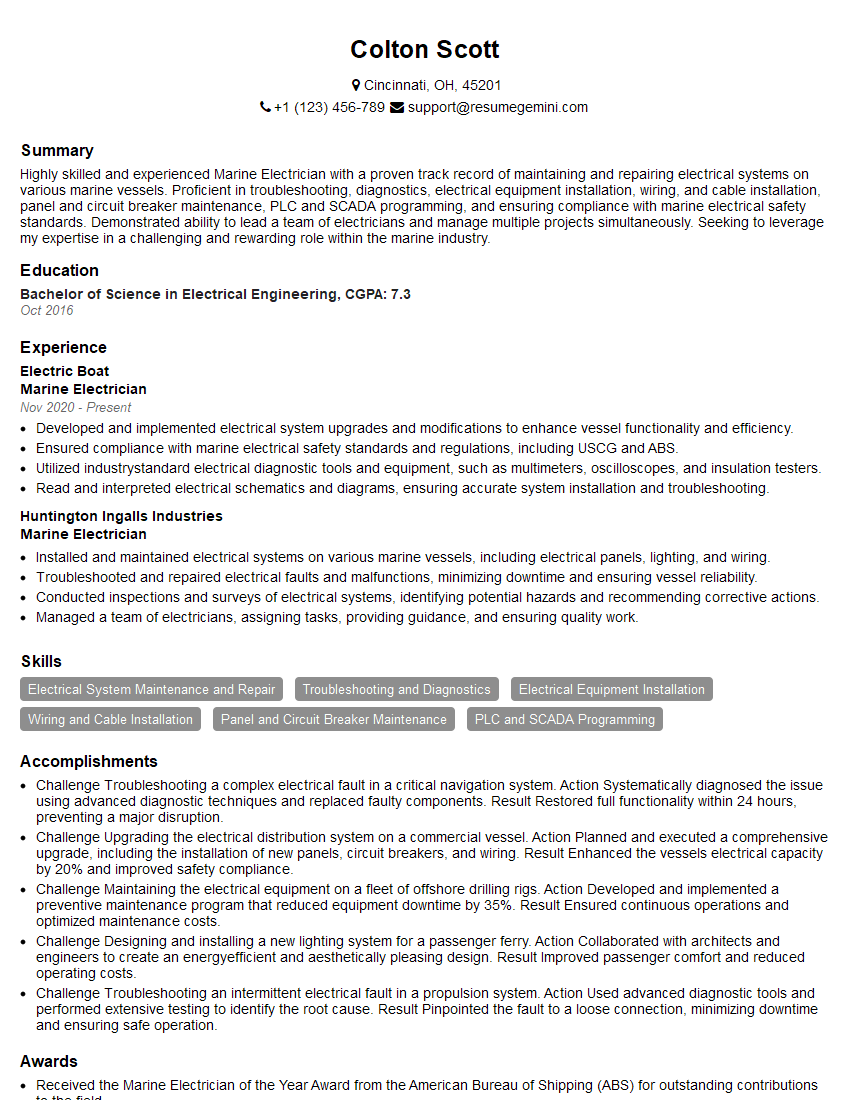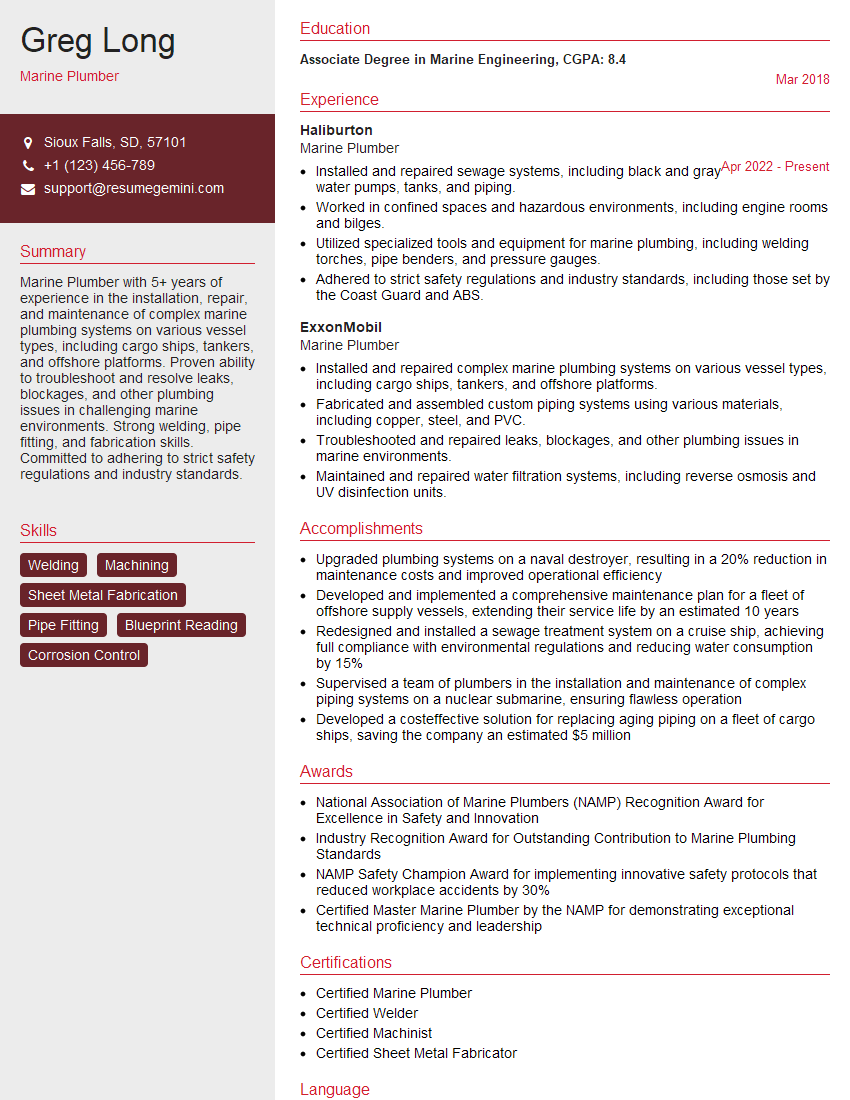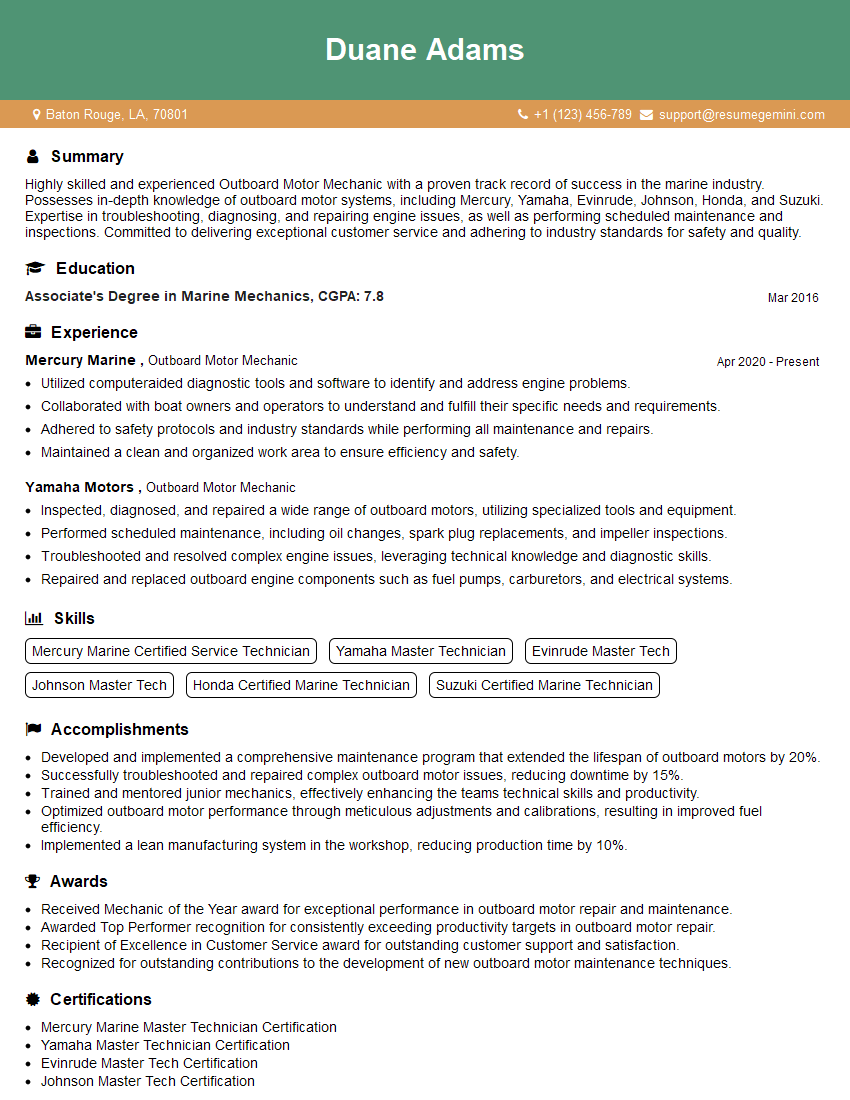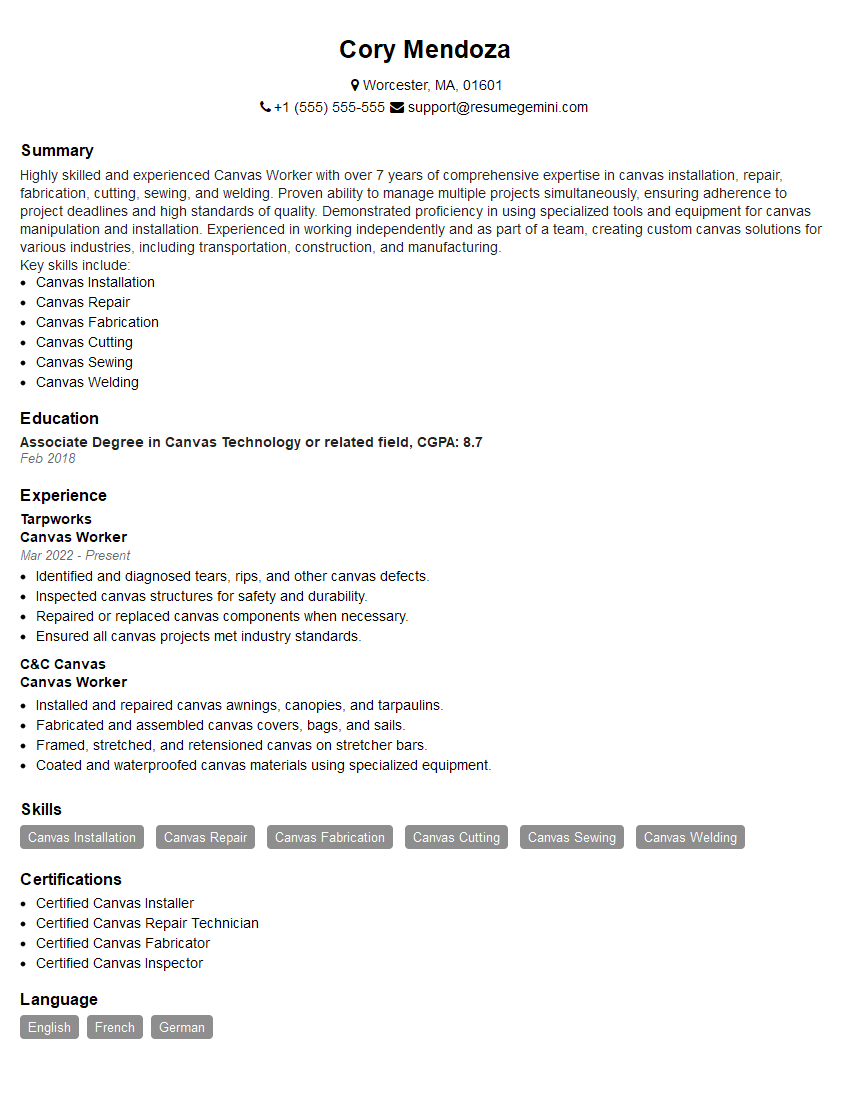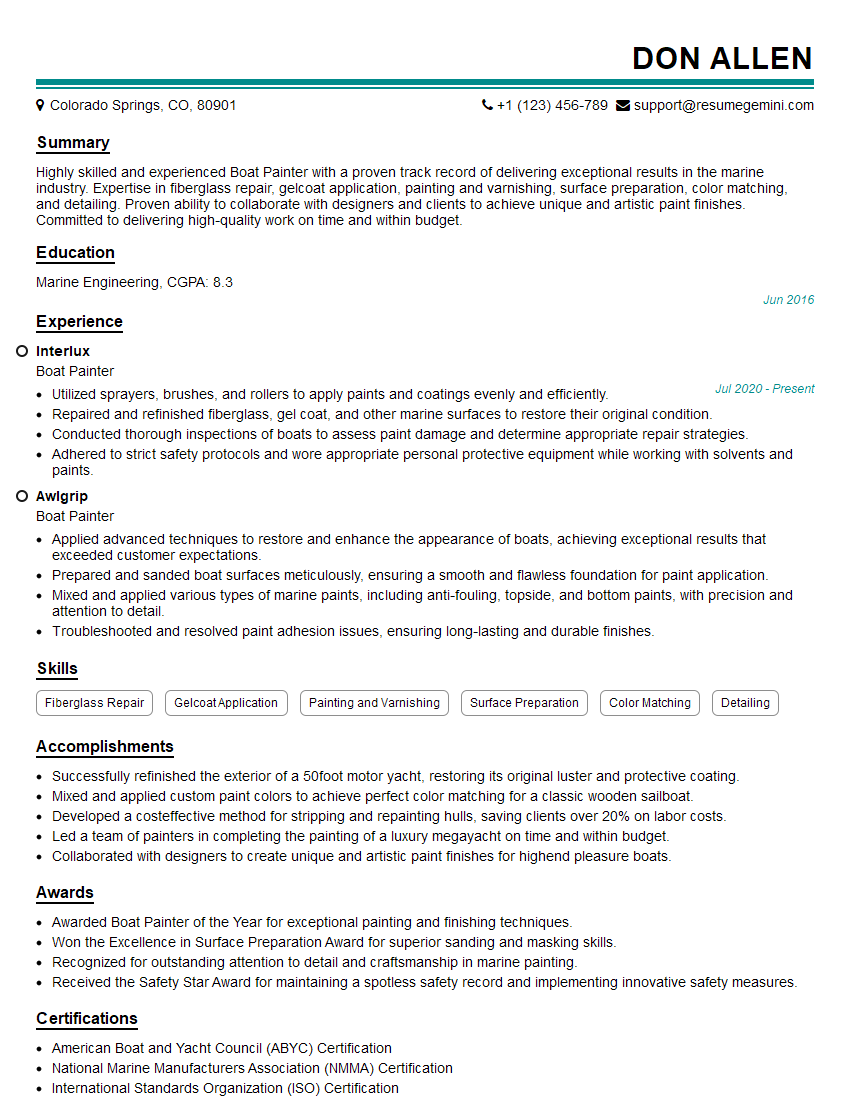Unlock your full potential by mastering the most common Boat building and repair interview questions. This blog offers a deep dive into the critical topics, ensuring you’re not only prepared to answer but to excel. With these insights, you’ll approach your interview with clarity and confidence.
Questions Asked in Boat building and repair Interview
Q 1. Describe your experience with fiberglass repair techniques.
Fiberglass repair is a crucial skill in boat building and maintenance. It involves patching, filling, and strengthening damaged fiberglass components. The process often begins with careful preparation. This includes cleaning the area to be repaired, removing any loose or damaged material, and ensuring a sound base for the repair. Then, depending on the severity of the damage, various techniques can be employed. For small cracks or chips, a simple filler and sanding process might suffice. For more extensive damage, layers of fiberglass cloth and resin are applied, building up the strength and integrity of the hull.
For example, I once repaired a significant crack in the hull of a 25-foot sailboat. The process involved carefully cleaning the crack, widening it slightly to allow for better resin penetration, then applying several layers of woven fiberglass cloth saturated with epoxy resin. Each layer was allowed to cure before applying the next, creating a strong, seamless repair. After curing, I carefully faired (smoothed) the repair using progressively finer grades of sandpaper, then primed and painted the area to match the rest of the hull. This technique ensures a durable, aesthetically pleasing, and structurally sound repair.
Proper mixing ratios of resin and hardener are crucial for a successful repair. Using too much hardener will lead to brittleness, while too little will result in insufficient curing. Experienced boat builders understand the importance of using high-quality materials and meticulously following the manufacturer’s instructions.
Q 2. Explain the process of hull cleaning and maintenance.
Hull cleaning and maintenance are essential for preserving the boat’s structural integrity and aesthetics. Regular cleaning prevents the build-up of marine growth (barnacles, algae), which can affect performance and damage the hull. The process usually begins with rinsing the hull thoroughly with fresh water to remove loose dirt and debris.
Next, I typically use a pressure washer to remove heavier fouling, followed by scrubbing with a stiff brush and a marine-grade cleaning solution. For stubborn marine growth, more aggressive methods may be needed, such as using a specialized scraper or applying an anti-fouling product. After cleaning, a thorough rinsing is vital to remove all traces of cleaning solution.
Following cleaning, it is essential to inspect the hull for any signs of damage, such as cracks, blisters, or osmosis (a common problem in fiberglass hulls). Any discovered damage requires immediate attention and repair. Regular waxing helps protect the fiberglass from UV degradation and provides a smoother surface, reducing drag in the water. The frequency of cleaning and maintenance depends on the boat’s usage and environmental conditions. A boat used frequently in saltwater may require more frequent cleaning than one kept in freshwater and used less often.
Q 3. What are the common causes of engine overheating in boats?
Engine overheating in boats can be caused by several factors. The most common are problems with the cooling system. This system might be compromised due to a lack of coolant, a faulty impeller (in boats with raw water cooling), clogged water passages, or a malfunctioning thermostat. A corroded heat exchanger or a blocked exhaust system can also cause overheating.
Another significant factor is inadequate lubrication. Insufficient engine oil can lead to excessive friction and heat buildup. A failing oil cooler can also cause this problem. Additionally, air pockets in the cooling system, a faulty water pump, or a damaged belt drive to the water pump can cause overheating.
Finally, a problem with the engine itself, such as a failed head gasket or worn piston rings, might be a root cause. Regular maintenance, including checking coolant levels, inspecting the impeller, and ensuring proper lubrication, is crucial to prevent engine overheating. Ignoring these warning signs can cause substantial engine damage.
Q 4. How do you diagnose and repair leaks in a fiberglass hull?
Diagnosing and repairing leaks in a fiberglass hull requires a systematic approach. First, the leak must be precisely located. This can often be done by filling the boat with water, then carefully inspecting the hull, both inside and out, looking for signs of water ingress. Using dye or a leak detection spray can help visualize the leak location.
Once the leak is identified, the area needs to be carefully prepared before initiating any repair. This involves cleaning and drying the affected area. Small leaks can often be repaired using epoxy resin and fiberglass cloth, following the layering technique mentioned earlier. For larger leaks or more significant damage, more extensive repairs might involve structural reinforcements or even replacing a section of the hull. After the repair, the area should be carefully sanded, primed, and painted to ensure a waterproof seal and to provide cosmetic restoration.
In some instances, underwater repairs may be necessary, requiring the use of specialized underwater epoxy and materials. These repairs are best left to experienced professionals using appropriate diving and safety equipment. Thorough testing after the repair is critical to ensure the leak is successfully sealed.
Q 5. What types of wood are suitable for boat construction?
Choosing the right wood for boat construction depends on several factors, including the type of boat, its size, the intended use, and the budget. Several types of wood are traditionally used in boatbuilding, each possessing specific properties that make them suitable for certain applications.
- Teak: Highly durable, naturally water-resistant, and beautiful, often used for decks, trim, and exterior components. Expensive.
- Oak: Strong, durable, and readily available, but requires more maintenance. Suitable for structural components.
- Cedar: Lightweight, rot-resistant, and easily worked, ideal for planking and interior components.
- Mahogany: Strong, durable, and visually appealing, commonly used for planking and interior finishes. Often expensive.
- Pine: More affordable, but less durable and rot-resistant. Suitable for framing and less critical parts.
The selection process often involves considering the wood’s resistance to rot and decay, its strength-to-weight ratio, its workability, and its aesthetic qualities. Proper treatment and maintenance are essential regardless of the chosen wood type to ensure the longevity of the boat.
Q 6. Explain the different types of boat paints and their applications.
Boat paints serve a critical function, protecting the hull from the harsh marine environment, and enhancing its appearance. Different types of paint are designed for various purposes.
- Primers: Applied before the topcoat, primers provide a better adhesion surface for the topcoat and offer corrosion protection for metal parts.
- Underwater Hull Paints (Anti-fouling): These paints contain biocides that prevent marine growth from attaching to the hull, improving performance and reducing drag.
- Topside Paints: These paints are designed to protect the hull above the waterline from UV degradation, weathering, and abrasion. They come in a variety of colors and finishes.
- Epoxy Paints: Often used for their superior durability and adhesion. Excellent for underwater applications.
- Varnish: Used to protect and enhance the beauty of wooden components. Requires regular maintenance.
The choice of paint depends on the substrate (fiberglass, wood, metal), the location (above or below the waterline), and the desired aesthetic and protective qualities. Proper surface preparation is crucial for optimal paint adhesion and longevity.
Q 7. Describe your experience with marine electrical systems.
My experience with marine electrical systems encompasses both installation and troubleshooting. This includes working with various components such as batteries, alternators, wiring, switches, circuit breakers, lighting systems, and navigation equipment. A deep understanding of 12V and 24V systems is critical in this field due to the unique challenges presented by marine environments, particularly concerning corrosion and moisture.
I’ve worked extensively on diagnosing and repairing electrical faults on various vessels, ranging from small day boats to larger yachts. Troubleshooting often involves systematically checking circuits, testing components, and identifying voltage drops or short circuits. Proper grounding and bonding are fundamental to the safe and reliable operation of marine electrical systems. I often use multimeters, clamp meters, and other diagnostic tools to locate and resolve problems. Safety is paramount when working with electrical systems, and following established marine electrical safety standards is always prioritized. Knowledge of AC and DC systems, along with appropriate safety procedures, is vital for effective and safe work.
One particular project involved tracing a mysterious power loss on a yacht. Using a multimeter, I systematically checked the wiring, discovering a corroded connection hidden within a junction box. Replacing the corroded connector resolved the problem, highlighting the importance of regular inspection and maintenance in preventing electrical failures in marine environments.
Q 8. How do you troubleshoot and repair a malfunctioning outboard motor?
Troubleshooting a malfunctioning outboard motor requires a systematic approach. Think of it like diagnosing a car engine – you need to isolate the problem step-by-step.
- Safety First: Disconnect the battery before starting any work. This prevents accidental shocks or shorts.
- Visual Inspection: Begin with a thorough visual check for obvious problems like loose connections, fuel leaks, damaged wires, or debris in the propeller.
- Start-Up Check: Attempt to start the motor. Note any unusual sounds (knocking, grinding, etc.) or behavior (sputtering, stalling). This helps narrow down the potential issues.
- Fuel System Check: Verify the fuel supply. Is the tank full? Is the fuel line clear and undamaged? Check the fuel filter for clogs. A clogged filter restricts fuel flow, causing poor performance or no start.
- Spark Check: Test the spark plugs. A weak or absent spark prevents combustion. Use a spark plug tester to confirm a strong spark at each plug.
- Compression Test: If the motor cranks but won’t start, a compression test checks the integrity of the engine’s cylinders. Low compression suggests worn piston rings or other internal damage requiring professional attention.
- Carburetor/Fuel Injection Issues: If the motor starts but runs poorly, carburetor cleaning or fuel injection system diagnostics might be necessary. This often requires specialized tools and knowledge.
- Troubleshooting Charts & Manuals: Always consult the outboard motor’s manual. Most manufacturers provide troubleshooting charts to guide you through common problems.
Example: I once had a boat whose outboard wouldn’t start. After checking the fuel, I found a corroded connection at the battery terminal. Cleaning the terminal and tightening the connection solved the issue.
Q 9. What safety precautions do you follow when working on boats?
Boat repair is inherently risky. Safety is paramount.
- Personal Protective Equipment (PPE): Always wear appropriate PPE, including safety glasses, gloves, and closed-toe shoes. For tasks involving fiberglass or chemicals, a respirator is essential.
- Working Environment: Ensure adequate lighting and ventilation, especially when working in confined spaces or with volatile chemicals.
- Fire Prevention: Keep a fire extinguisher readily accessible, especially when working with flammable materials like gasoline or solvents. Know how to use it!
- Water Safety: When working on or near water, wear a personal floatation device (PFD). Never work alone near water.
- Electrical Safety: Always disconnect the battery before working on electrical systems. Use insulated tools and be aware of potential shock hazards.
- Proper Lifting Techniques: Boat parts can be heavy. Use proper lifting techniques to prevent injury. Consider using mechanical assistance like hoists or cranes for large items.
- Emergency Planning: Have a communication plan in place in case of an emergency. Inform someone of your work location and expected completion time.
Example: Before working on a client’s boat’s electrical system, I always disconnect the battery, clearly label the terminals, and take photos of the wiring configuration before I begin any work.
Q 10. Explain the process of applying a gel coat to a fiberglass hull.
Applying gel coat to a fiberglass hull is a multi-step process that requires precision and care for a smooth, durable finish. Think of it as painting a very large, curved canvas.
- Surface Preparation: This is the most critical step! The fiberglass surface must be thoroughly cleaned, sanded, and degreased to ensure proper adhesion. Any imperfections or contaminants will show through the gel coat.
- Waxing and Polishing: After sanding, apply a wax or polishing compound to create a smooth, even surface for the gel coat.
- Primer Application (If Necessary): If repairing a damaged area, you may need to apply a primer to help the gel coat adhere to the repaired surface. This is crucial for optimal results and longevity.
- Gel Coat Application: Using a brush, roller, or spray gun, apply thin, even coats of gel coat. Work in overlapping strokes to avoid runs or sags. Allow each coat to cure properly before applying the next. This varies by gel coat type and environment, always follow manufacturer’s instructions.
- Curing: The gel coat needs time to cure, typically 24-72 hours, depending on temperature and humidity. Avoid dust and debris during curing.
- Sanding and Polishing (After Curing): Once cured, sand and polish the gel coat to achieve a smooth, glossy finish. This may involve several stages of sanding with progressively finer grit sandpaper.
- Buffing and Waxing: Final polishing and waxing produces the high-gloss finish that you see on most fiberglass boats.
Example: When applying gel coat, I always work in a well-ventilated area and wear a respirator to prevent inhalation of the fumes.
Q 11. How do you identify and repair wood rot in a boat?
Wood rot in a boat is a serious issue that can compromise the structural integrity of the vessel. Early detection and prompt repair are crucial.
- Visual Inspection: Look for signs of discoloration, softness, crumbling wood, or fungal growth (white, gray, or black fuzzy patches). Tap suspect areas with a screwdriver; a hollow sound often indicates rot.
- Probe Test: Use an awl or ice pick to probe the affected area. If it easily penetrates, the wood is likely rotten.
- Removal of Rotted Wood: Carefully remove all the affected wood, excavating back to sound, firm wood. You may need to use chisels, scrapers, or even a rotary tool with a sanding attachment. Ensure clean cuts to maximize adhesion of the replacement wood.
- Wood Replacement: Use marine-grade plywood or solid wood for repairs, ensuring that the replacement wood is properly sized and shaped to fit the existing structure. Epoxy resin is commonly used to bond wood in marine environments. The bonding needs to be strong to prevent future water ingress and rot.
- Sealing: After the repair is complete, seal the repaired area with epoxy resin and/or a marine sealant to prevent future moisture penetration.
- Finish: Once the sealant is dry, apply a suitable marine finish, such as varnish or paint, to protect the wood from further deterioration.
Example: I recently repaired a transom with extensive rot. I had to carefully remove all the compromised wood and replace it with marine-grade plywood, using epoxy resin to ensure a strong, watertight bond.
Q 12. Describe your experience with marine plumbing systems.
Marine plumbing systems are unique because they must withstand the corrosive effects of saltwater and the constant motion of the boat. They are typically made from materials resistant to corrosion like stainless steel, bronze, or high-quality PVC.
My experience encompasses:
- Installation and Repair of Water Systems: This includes freshwater tanks, pumps, plumbing lines, sinks, showers, and toilets. Understanding pressure regulators and water heaters is also important.
- Wastewater Systems: I’m proficient in installing, maintaining, and repairing holding tanks, macerators, and discharge systems. Proper ventilation is critical to prevent unpleasant odors.
- Bilge Pump Systems: Bilge pumps are crucial for removing water that accumulates in the bilge. I can troubleshoot problems, replace components, and ensure proper functionality.
- Troubleshooting Leaks and Clogs: I have experience locating and repairing leaks in plumbing systems, using pressure testing and dye tracing methods when necessary. Knowing how to clear clogs in lines is also a valuable skill.
Example: A client’s boat had a persistent leak in the freshwater system. After a thorough inspection, I discovered a corroded fitting that needed replacement. Replacing it with a stainless steel fitting and performing a pressure test ensured a leak-free system.
Q 13. What are the different types of boat rigging?
Boat rigging refers to the system of ropes, wires, and fittings used to support and control a sailboat’s masts, sails, and other components. Different types of rigging cater to different hull designs and sailing styles.
- Standing Rigging: This provides the permanent structural support for the mast and sails. It includes shrouds (lateral support), stays (fore-and-aft support), and backstays. It’s typically made of stainless steel wire.
- Running Rigging: This includes the lines used to control the sails and adjust their shape. This includes halyards (to hoist sails), sheets (to control sail trim), and control lines for various sail adjustments.
- Fractional Rig: The forestay (the wire that supports the front of the mast) is attached lower on the mast than a masthead rig. This is a popular choice for cruisers.
- Masthead Rig: The forestay runs from the top of the mast to the bow. This design is common in racing sailboats because of its high performance.
- Cutter Rig: Has a smaller forestay (inner forestay) in addition to the main forestay. This configuration allows for more efficient sail handling in various conditions.
Example: I recently worked on a boat that required a complete overhaul of its standing rigging. The old wire was showing signs of wear and tear, so we replaced it with new stainless steel wire, ensuring that all connections were properly swaged (crimped) for maximum strength and safety.
Q 14. How do you maintain and repair sails?
Sail maintenance and repair are essential for optimal performance and longevity. Think of sails like delicate, high-performance fabrics that need care.
- Regular Cleaning: Clean sails regularly to remove salt, mildew, and other contaminants. Freshwater rinsing after each use is highly recommended.
- Inspection for Damage: Regularly inspect sails for tears, rips, chafe, UV damage, and stitching failure. Address small problems early to prevent them from becoming bigger issues.
- Repairing Minor Damage: Small tears and rips can often be repaired using sail repair tape or patches. The appropriate choice will depend on sail fabric and damage severity.
- Professional Repairs: Larger or more complex repairs may require the expertise of a sailmaker. They have specialized tools and knowledge to ensure a proper repair.
- Storage: Proper storage is critical. Store sails in a cool, dry place away from direct sunlight and moisture to prevent mildew and UV damage. Using sail bags or covers helps.
- UV Protection: Sun is the biggest enemy for sails! Apply UV protectant sprays to minimize damage from the sun’s harmful rays. Regular application can extend the life of your sails significantly.
Example: I once repaired a sail with a significant rip using a specialized sail repair kit. This involved applying a patch on the inside and outside of the sail, then reinforcing the area with additional stitching to maintain strength.
Q 15. Explain the importance of proper boat ventilation.
Proper boat ventilation is crucial for preventing the buildup of dangerous gases, particularly carbon monoxide (CO), and for maintaining a comfortable and safe environment onboard. CO is odorless and colorless, making it a silent killer. Inadequate ventilation can lead to CO poisoning, a serious and potentially fatal condition. Furthermore, dampness and mold thrive in poorly ventilated areas, causing structural damage and health problems for occupants.
Effective ventilation systems involve a combination of inlets and outlets strategically placed to ensure consistent airflow. Inlets should be positioned low to draw in fresh air, while outlets are placed high to expel stale, moist air. Consideration should be given to the type and size of vents to ensure adequate air exchange, taking into account the size and design of the boat. For example, a larger cabin cruiser will require a more robust ventilation system than a small sailboat.
During my work, I’ve seen several instances where poor ventilation led to serious issues. One memorable case involved a client whose family experienced mild CO poisoning after spending several hours in their poorly ventilated cabin. This highlighted the urgent need for proper ventilation planning during boat design and regular maintenance checks, such as ensuring vents aren’t blocked or malfunctioning.
Career Expert Tips:
- Ace those interviews! Prepare effectively by reviewing the Top 50 Most Common Interview Questions on ResumeGemini.
- Navigate your job search with confidence! Explore a wide range of Career Tips on ResumeGemini. Learn about common challenges and recommendations to overcome them.
- Craft the perfect resume! Master the Art of Resume Writing with ResumeGemini’s guide. Showcase your unique qualifications and achievements effectively.
- Don’t miss out on holiday savings! Build your dream resume with ResumeGemini’s ATS optimized templates.
Q 16. Describe your experience with composite materials in boat building.
I have extensive experience working with composite materials, primarily fiberglass reinforced polymers (FRP), in boat building. Fiberglass offers a great strength-to-weight ratio, making it ideal for marine applications. My expertise spans the entire process, from initial layup and curing to final finishing and repair. I’m proficient in various techniques including hand layup, spray-up, and vacuum infusion, each suited to different boat sizes and complexities.
Vacuum infusion, for example, allows for a very precise and controlled process leading to a lighter, stronger, and more consistent hull. I’ve utilized this technique on several projects where high strength and low weight were critical factors. Conversely, hand layup offers greater flexibility for complex shapes, while spray-up is often preferred for larger-scale production. Understanding the material properties and limitations, as well as selecting appropriate resins and fabrics for specific applications, is critical for success. For example, using UV-resistant resins is crucial for extending the lifespan of the boat and preventing deterioration.
Beyond fiberglass, I also have experience with carbon fiber and other advanced composites, though fiberglass remains the dominant material in most boat building projects due to its cost-effectiveness and relatively simple processing.
Q 17. How do you perform a pre-purchase inspection of a boat?
A pre-purchase boat inspection is a critical step before buying a used vessel. It aims to identify potential problems and hidden defects to prevent costly surprises down the line. My inspection process is thorough and systematic, covering several key areas.
- Hull Inspection: This involves a visual inspection for cracks, blisters, osmosis (a common problem in fiberglass hulls), and other signs of damage. I carefully examine the keel, hull-to-deck joint, and through-hull fittings.
- Deck and Superstructure: I check for delamination (separation of layers in composite structures), cracks, and leaks. I also assess the condition of handrails, stanchions, and other deck hardware.
- Engine and Mechanical Systems: A thorough examination of the engine’s functionality, including compression testing, oil analysis, and a check of all fluids. I also inspect the fuel system, electrical systems, plumbing, and steering mechanism.
- Sails and Rigging (if applicable): For sailboats, a careful inspection of sails, rigging, and standing and running rigging for wear and tear, proper tension, and potential damage.
- Interior and Systems: Assessing the condition of the interior, including cabinetry, upholstery, and electrical and plumbing fixtures.
I always recommend hiring a qualified marine surveyor for a comprehensive inspection, especially for larger or more expensive vessels. Their expertise provides an objective assessment and protects the buyer’s investment. Even experienced boaters can miss subtle problems that could indicate serious underlying issues.
Q 18. What are the common causes of engine misfires?
Engine misfires are a common problem that can stem from a variety of causes. Identifying the root cause requires a systematic approach. Here are some of the most frequent culprits:
- Spark Plugs: Worn, fouled, or improperly gapped spark plugs are a leading cause of misfires. They prevent the proper ignition of the air-fuel mixture.
- Ignition System: Problems within the ignition system, such as a faulty ignition coil, distributor cap, or rotor, can interrupt the spark delivery.
- Fuel System: Issues like clogged fuel injectors, low fuel pressure, or contaminated fuel can prevent the engine from receiving the proper fuel mixture.
- Air Intake System: A restricted air intake, dirty air filter, or vacuum leaks can disrupt the air-fuel ratio.
- Sensors: Faulty sensors, such as the oxygen sensor, mass airflow sensor, or crankshaft position sensor, can provide inaccurate data to the engine’s computer, leading to misfires.
- Valve Train Problems: Worn or damaged valves, or issues with valve timing, can also cause misfires.
Troubleshooting often involves a combination of visual inspection, diagnostic testing using specialized tools, and systematic elimination of potential causes. A skilled marine mechanic will use diagnostic equipment to pinpoint the exact cause of the misfire and implement appropriate repairs. Neglecting a misfire can lead to further engine damage.
Q 19. Explain the process of replacing a propeller.
Replacing a propeller involves several steps and requires the right tools and safety precautions. Here’s a general outline of the process:
- Secure the Boat: Ensure the boat is securely moored or otherwise stable to prevent accidental movement.
- Access the Propeller: Remove any access panels or components that obstruct access to the propeller shaft.
- Disconnect the Shaft: Depending on the boat’s design, this might involve disconnecting the propeller shaft from the engine or gearbox. This step often requires specialized tools.
- Remove the Propeller Nut: Use a propeller nut wrench to carefully remove the nut securing the propeller to the shaft. This can be challenging, and a proper wrench is essential to prevent damage.
- Remove the Propeller: Once the nut is removed, the propeller can typically be pulled off the shaft. Sometimes, a puller tool may be necessary.
- Install the New Propeller: Install the new propeller, ensuring it is correctly seated on the shaft.
- Replace the Nut: Tighten the nut to the manufacturer’s specified torque. Improper tightening can lead to damage or propeller failure.
- Reconnect the Shaft (if necessary): Reconnect the propeller shaft to the engine or gearbox.
- Reassemble Access Panels: Replace any access panels or components removed earlier.
- Test the Propeller: Before departing, test the propeller to ensure it spins freely and doesn’t exhibit any vibrations.
Always refer to the boat’s manual for specific instructions and torque specifications. Improper installation can lead to serious problems, including propeller damage or engine failure. If you’re not comfortable performing this task yourself, seek the assistance of a qualified marine mechanic.
Q 20. How do you repair cracks in a fiberglass hull?
Repairing cracks in a fiberglass hull requires careful preparation and execution to ensure a durable and watertight repair. The process generally involves the following steps:
- Preparation: Clean the cracked area thoroughly, removing any loose material or debris. This often requires grinding or sanding the area to create a sound surface for bonding.
- Fabric Selection: Choose a suitable fiberglass cloth or mat, selecting a weight appropriate for the size and severity of the crack. Often, several layers are required for strength.
- Resin Preparation: Mix the appropriate resin and hardener according to the manufacturer’s instructions. Ensure the mixture is thoroughly blended to avoid inconsistencies in curing.
- Layup: Apply the resin to the fiberglass cloth and carefully lay it over the crack, ensuring complete saturation. Multiple layers may be needed, allowing each layer to cure slightly before applying the next.
- Curing: Allow the repair to cure fully, following the resin manufacturer’s recommendations. This often takes several hours or even overnight.
- Finishing: Once cured, sand the repair area smooth, using progressively finer grits of sandpaper. Apply a suitable primer and topcoat to provide UV protection and a cosmetic finish.
For larger or more complex cracks, it may be necessary to use additional reinforcement materials, such as backing plates or additional layers of fiberglass. In cases of significant structural damage, professional repair is always recommended. A poorly executed repair can compromise the structural integrity of the hull and lead to significant safety hazards. Remember that a successful repair depends heavily on proper surface preparation and the use of high-quality materials.
Q 21. Describe your experience with different types of boat construction methods (wood, fiberglass, aluminum).
My experience encompasses a wide range of boat construction methods, including wood, fiberglass, and aluminum. Each has unique properties and challenges:
- Wood: Wood construction, though more labor-intensive, offers a unique aesthetic appeal and can result in incredibly strong and durable vessels when done properly. It requires specialized skills in joinery and traditional boatbuilding techniques. Proper treatment and maintenance are crucial to prevent rot and degradation. Examples include classic wooden yachts and smaller craft.
- Fiberglass: As discussed earlier, fiberglass offers a high strength-to-weight ratio, relative ease of production, and good resistance to corrosion. It’s the most common material used in modern boat building, ranging from small dinghies to large powerboats. The techniques involved vary from hand layup to vacuum infusion, impacting the resulting product’s quality and cost.
- Aluminum: Aluminum boats offer exceptional corrosion resistance and are commonly used in situations where lightweight construction is crucial, like in high-speed powerboats or specialized vessels. They’re relatively easy to repair but require specialized welding techniques. However, Aluminum is susceptible to fatigue and requires more attention to prevent stress cracking.
My experience extends to working with hybrid designs that might incorporate multiple materials to leverage their individual strengths. For instance, a boat might have an aluminum hull with a fiberglass deck. A deep understanding of the material properties and how they interact is crucial for success in any boatbuilding project.
Q 22. What software or CAD programs are you familiar with?
My CAD software proficiency spans several industry-standard programs. I’m highly experienced with Rhino 3D, particularly its marine-specific plugins that allow for precise hull design and 3D modeling of complex boat components. I also have a strong working knowledge of AutoCAD, which is invaluable for creating detailed construction plans, diagrams, and documentation. For simpler designs and quick mock-ups, I utilize SketchUp, appreciating its intuitive interface and rendering capabilities. Finally, I’m familiar with SolidWorks, used mainly for creating detailed models of mechanical components and fittings for boats.
For example, when designing a custom sailboat, I would start with Rhino 3D to model the hull shape, using plugins to ensure hydrodynamic efficiency. Then I’d switch to AutoCAD to create detailed construction plans, including precise measurements for cutting lumber and fitting components. SolidWorks would be used to model the rudder assembly, ensuring all parts fit perfectly and function flawlessly.
Q 23. What is your experience with marine surveying?
My experience in marine surveying is extensive, encompassing both pre-purchase surveys and damage assessments. A pre-purchase survey involves a thorough examination of a vessel’s hull, deck, systems (electrical, plumbing, engine), and rigging to identify any potential issues before a sale. I meticulously document my findings, providing detailed reports with photographic evidence. Damage assessments, on the other hand, focus on the extent of damage after an incident, such as a collision or grounding. This includes determining the cause of the damage, estimating repair costs, and recommending repair strategies.
For instance, during a pre-purchase survey, I once discovered significant dry rot in the transom of a seemingly well-maintained sailboat, a hidden problem that could have resulted in a costly repair for the buyer. In a damage assessment, I helped determine the extent of damage to a fishing boat that had collided with a submerged object, leading to the accurate estimation of repair costs for the insurance company.
Q 24. How do you handle emergency situations on the water?
Handling emergency situations on the water requires quick thinking and decisive action. My approach follows a structured methodology: Assess, Communicate, Act, and Evaluate.
- Assess the situation: Identify the nature of the emergency (engine failure, fire, collision, medical emergency, etc.) and assess the immediate risks.
- Communicate: Immediately contact emergency services (coast guard, etc.) and relay the essential details – location, nature of the emergency, number of people on board, etc. If possible, use VHF radio.
- Act: Take immediate action to mitigate the risk based on the assessment. This might involve activating emergency equipment (life jackets, flares, EPIRB), initiating damage control, or administering first aid.
- Evaluate: After the emergency, assess the situation to identify what worked well and what could be improved for future scenarios. This includes reviewing emergency preparedness procedures and equipment.
For example, I once had to deal with a sudden engine failure far from shore. I quickly assessed the situation, contacted the coast guard, deployed my life raft and emergency radio beacon, and calmly waited for assistance, ensuring the safety of all passengers. The post-incident review highlighted the importance of regular engine maintenance and carrying extra fuel.
Q 25. Describe your experience working with different types of adhesives and sealants.
My experience with marine adhesives and sealants is vast, covering a wide range of products tailored for specific applications in boat building and repair. I’m familiar with epoxy resins (West System, etc.) for high-strength bonding of structural components, polyurethane adhesives for bonding dissimilar materials, and various types of silicone and polysulfide sealants for caulking seams and preventing leaks. The choice of adhesive or sealant depends critically on the material being bonded, the environmental conditions, and the required strength and flexibility.
For example, when repairing a fiberglass hull, I might use epoxy resin to bond a patch over a crack, ensuring a strong, durable repair. For sealing deck joints, a flexible polyurethane sealant would be preferred to accommodate expansion and contraction due to temperature changes. Choosing the wrong adhesive can lead to failures, compromising the boat’s integrity and safety. This necessitates a thorough understanding of the material properties and application techniques.
Q 26. Explain the process of installing marine hardware.
Installing marine hardware requires precision and attention to detail, as improper installation can lead to failures and compromise the safety of the vessel. The process generally includes:
- Preparation: Thoroughly clean and prepare the mounting surface, ensuring it’s free of debris and corrosion. This may involve sanding or using a primer.
- Drilling (if necessary): Carefully drill pilot holes to prevent cracking or splitting of the material. Use appropriate drill bits for the material type.
- Fastening: Choose the correct fasteners (screws, bolts, rivets) based on the material being fastened and the load requirements. Use appropriate washers and sealant to prevent corrosion and water ingress.
- Securing: Tighten the fasteners to the manufacturer’s specifications, being careful not to overtighten, which can cause damage.
- Finishing: Apply a sealant around the hardware to further prevent water ingress. Touch up paint or varnish if necessary.
For example, when installing deck fittings, I would carefully drill pilot holes using a countersink bit to ensure a flush finish. Stainless steel screws with appropriate washers would be used, and the holes would be sealed with silicone sealant to prevent corrosion and water damage. The entire process demands precise measurements and careful consideration of stress points.
Q 27. How do you ensure compliance with safety regulations?
Ensuring compliance with safety regulations is paramount. I maintain a detailed understanding of all relevant regulations, including those related to hull construction, electrical systems, engine installation, fire safety, and life-saving equipment. This involves staying updated on current standards (e.g., ABYC standards in the US). I meticulously document all work, keeping detailed records of materials used, inspections performed, and any modifications made to the vessel. This documentation is essential not only for regulatory compliance but also for providing a complete history of the vessel’s maintenance and repair.
For example, during engine installation, I would strictly adhere to ABYC standards regarding fuel system installation, ensuring proper venting, fuel line routing, and fire suppression systems. All electrical work would be performed in accordance with ABYC electrical standards, ensuring proper grounding, bonding, and circuit protection to prevent electrical fires. Each step is documented, and any deviations from standard practices are clearly noted and justified.
Q 28. What are your strengths and weaknesses as a boat builder/repair technician?
My strengths lie in my meticulous attention to detail, my problem-solving skills, and my extensive experience across various boat types and repair techniques. I’m adept at diagnosing complex issues, developing effective repair strategies, and executing the work with precision and efficiency. My passion for boating and commitment to safety ensure high-quality workmanship.
A weakness I’m actively working on is delegating tasks effectively. While I strive for perfection, sometimes my desire for control slows down the overall process. I’m actively improving my project management skills to balance my commitment to quality with efficient teamwork. I actively seek feedback and implement strategies to improve my delegation and communication skills.
Key Topics to Learn for Boat Building and Repair Interviews
- Hull Construction: Understanding various hull materials (fiberglass, wood, aluminum), construction techniques (lamination, stitch-and-glue, riveting), and their strengths and weaknesses. Practical application: Diagnosing hull damage and recommending repair strategies.
- Decking and Superstructure: Knowledge of different decking materials and their installation, along with the construction and repair of bulkheads, cabins, and other superstructure components. Practical application: Troubleshooting leaks and repairing damaged decking.
- Systems and Components: Familiarity with boat systems including electrical (wiring, batteries, lighting), plumbing (water tanks, pumps, sanitation), and engine systems (inboard, outboard, sterndrive). Practical application: Troubleshooting system malfunctions and performing routine maintenance.
- Fiberglass Repair: Mastering techniques for repairing fiberglass cracks, gelcoat damage, and osmosis. Practical application: Estimating repair time and material costs for fiberglass repairs.
- Wood Repair: Understanding different wood types used in boat building, wood rot identification and treatment, and techniques for repairing wooden structures. Practical application: Restoring damaged wooden components using appropriate techniques.
- Safety and Regulations: Knowledge of relevant safety regulations, best practices for working on boats, and appropriate use of safety equipment. Practical application: Ensuring a safe working environment and adhering to industry standards.
- Estimating and Project Management: Ability to accurately estimate materials, labor costs, and project timelines. Practical application: Developing a realistic budget and schedule for boat repair projects.
- Problem-Solving and Troubleshooting: Developing a systematic approach to diagnosing and resolving complex boat repair issues. Practical application: Effectively troubleshooting a range of mechanical and structural problems.
Next Steps
Mastering boat building and repair skills opens doors to a rewarding career with diverse opportunities for growth, from independent contractor to leading roles in boatyards and manufacturing. To maximize your job prospects, creating a strong, ATS-friendly resume is crucial. ResumeGemini is a trusted resource to help you build a professional resume that highlights your skills and experience effectively. Examples of resumes tailored to the boat building and repair industry are available to help guide you. Take the next step in your career journey – build your best resume with ResumeGemini.
Explore more articles
Users Rating of Our Blogs
Share Your Experience
We value your feedback! Please rate our content and share your thoughts (optional).
What Readers Say About Our Blog
This was kind of a unique content I found around the specialized skills. Very helpful questions and good detailed answers.
Very Helpful blog, thank you Interviewgemini team.



